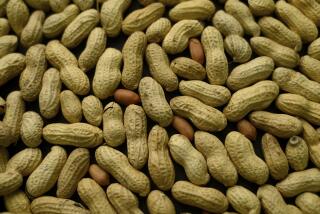Wise Parents Let Nutrition Get a Food in the Door
Bob and Lisa Jansen of Newport Beach had the best intentions for their preschool-age son, Kyle. Determined to provide him with nutritious lunches and snacks, they fed young Kyle fruits and vegetables.
All seemed well until Lisa picked up her son at preschool one day. Kyle’s teacher pulled her aside tell her that the quiet 4-year-old had discovered the wonders of cupcakes and cookies and decided to help himself to his pals’ lunchtime offerings.
“Perhaps you could include some more interesting items for Kyle,” the teacher suggested.
“All I could do was laugh,” said Lisa. “I went home that night and said, ‘Well, maybe we better go buy some hot dogs.’ ”
The Jansens’ story is all too typical. You may send your little darlings to school with bran muffins, but it’s a sure bet that they’ll be swapped for a Ding Dong before you can say “better nutrition.”
But that doesn’t have to be the case, according to Annette Globits, a Fountain Valley-based registered dietitian in private practice. All it takes is a little imagination and a basic understanding of nutrition.
Why is it so important for children to receive proper nutrition? The most common reasons are that people tend to follow the eating habits they learned when they were young, and research now indicates that plaque can start building in the arteries during early childhood.
“Our most common childhood nutrition problems today are obesity in children and a diet that’s too high in fat,” Globits said. “By providing children with nutritious meals and snacks, we can eliminate many of these problems.
“Parents usually try to get their children to eat healthy foods, and sometimes children rebel. That’s when adults need to figure out ways to involve children in planning nutritious snacks and lunches.”
One way to achieve this is to allow children to help plan or fix snacks.
“I remember as a child making butter in a school class,” she said. “All the children were fascinated. One recommendation I would make to parents is to purchase a yogurt funnel and let your child make yogurt cheese.
“It’s lower in fat than the cream cheese that most children love, and the children can also make their cheese spread in any of the fruit flavors available in yogurt.”
The funnel, essentially a plastic mesh cone, is inserted into a tall glass. The child then spoons the contents of a yogurt carton (or two) into the funnel.
Over 24 to 48 hours, the whey and sugar from the yogurt will drip into the bottom of the glass, leaving behind in the funnel a fruity cheese spread.
“Children can choose any flavor they like, but the yogurt mustn’t contain any gelatin (which has sugar), so read the labels,” Globits said. “Nonfat yogurts like Dannon or Alta-Dena work very well.
“Once the yogurt is spooned into the funnel, simply cover it with plastic wrap and put it in your refrigerator. Children like to keep peeking in to check on it.”
Calcium is important for children’s developing bones, but some youngsters simply aren’t interested in drinking milk. For these youngsters, Globits suggests checking out fruit juice that has been fortified with calcium (such as Citrus Hill orange juice).
“Not only is this a good source of calcium, but it provides lots of Vitamin C as well,” said Globits.
Cheese can also provide calcium, but most types are high in fat.
“Children really like string cheese, and it’s great for a lunch or snack,” said Globits. “Look for a cheese like Frigo Truly Lite string cheese. It only has 2 grams of fat and is also an excellent source of protein.
“Lifetime Fat Free Cheese is another good cheese, as it has no fat and fewer calories. These cheeses are great for a children’s classic: the grilled cheese sandwich.”
Globits uses a small sandwich maker (no butter is needed) and makes quick grilled cheese sandwiches using fat-free cheese and whole wheat bread. She recommends letting your child help you make the sandwich.
“There’s really little to clean up, and it’s much healthier than grilling the sandwiches in butter,” she said.
Since most children’s lunch boxes contain a sandwich, look at the bread your child is eating. Wheat breads, whole-grain breads or other breads that are high in fiber are preferred. White bread has virtually no fiber.
“The best breads are mixed grains,” Globits said. “I know some children aren’t crazy about wheat bread, so most parents will be happy to know that Oroweat is planning on introducing a high-fiber white bread that we’ll begin seeing this summer.”
And what about the peanut butter and jelly sandwich, the perennial childhood favorite?
“Natural peanut butters are the best,” said Globits. “These are the kinds where you have to mix in the oil. But for children who won’t eat this kind of peanut butter, I’d recommend a low-sugar, low-fat version.”
Instead of spreading on the jelly, Globits recommends putting slices of fruit directly on the peanut butter (banana and apple slices or raisins seem to work well).
Fruit is always a good snack, but a study conducted by Sunkist determined that if oranges weren’t peeled, youngsters couldn’t be bothered with them.
“If you send oranges or tangerines in your children’s lunches, peel them beforehand,” Globits said.
Globits also recommends looking for fruits and vegetables that are a little different. The carambola fruit (also called the starfruit) is a hit among children because when sliced, the pieces resemble little stars.
“Don’t forget baby carrots either,” Globits said. “Carrots are the No. 1 favorite of children, and there’s something about the miniature shape of baby carrots that’s quite appealing.”
But is your child really going to down that banana when the kid sitting nearby is reaching for chocolate-chip cookies?
That’s when you should break out the Frosted Mini-Wheats, according to Globits.
“I know some will object to the frosting, but with about a half a cup of Frosted Mini Wheats, your child will receive about one teaspoon of sugar, much less than you’d find in a cookie,” said Globits. “And the Mini Wheats have zero fat and are high in fiber.”
If you child simply must have a cookie, try to find the more healthful versions.
Nabisco Devil’s Food Cakes are a healthier selection than chocolate-chip cookies, and Pepperidge Farm has a new “Wholesome Choice” line of cookies that contain less fat than some of their more calorie-laden counterparts.
Hostess also has a healthier version of its cupcakes. Hostess Grizzly Chumps cakes contain 1 gram of fat and 110 calories. Contrast that with Ding Dongs (9 grams of fat, 170 calories) or Oreos (2 grams of fat, 50 calories). Other good cookie selections include Fig Newtons and graham crackers.
If chips are your child’s downfall, look for the lower fat chips (such as “Guiltless Gourmet” tortilla chips that are baked, not fried), or substitute pretzels or unbuttered popcorn.
“You have to interest your child in good nutrition to gain their cooperation,” said Globits. “In my practice, the children I work with often aren’t aware of why one food is better than another.
“Sometimes we pick a fruit or vegetable of the week. Then we look for new recipes or ways to prepare it. Sometimes we have fun by using a pen shaped like a banana. Or let your child bring lunch to school in a bag decorated with carrots.
“Some of the children I see even share their fruit of the week during ‘show and tell.’ That gets their friends interested. Before you know it, with a little luck, you’ll have the whole school eating starfruit.”
More to Read
Sign up for Essential California
The most important California stories and recommendations in your inbox every morning.
You may occasionally receive promotional content from the Los Angeles Times.










